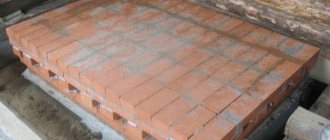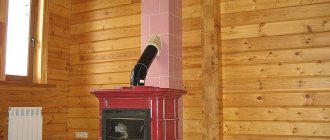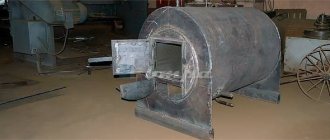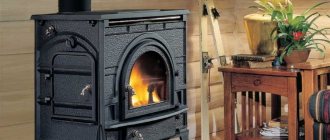How does a biofireplace work?
Unlike wood-burning fireplaces, eco-fireplaces have more of a decorative function - although heat is released when the flame burns, it is not enough to fully heat the room.
Biodevices do not require a chimney, hood or other additional elements that threaten to turn the installation of an accessory into a new renovation.
A biofireplace can be selected for any room and interior design - manufacturers offer a wide range of models of various shapes, sizes and colors
They run on liquid fuel, which produces a beautiful fire with even “tongues” of flame.
Design features of the device
An eco-fireplace is a fairly simple device that consists of three main components - a fuel block, a burner and a body made of non-flammable material (usually glass, heat-resistant plastic or metal). Most often, devices are also equipped with a backlight, a protective screen and a flame control regulator.
The fuel block is the most important structural element, which can be represented by a small tank with a fuel supply or an open container with a burner
Automated systems are also equipped with a remote control unit to control the device from a remote control, mobile phone or tablet.
And also many nice additions, for example:
- LED information display, which displays data about the current state of the device, possible breakdowns, and the presence of fuel in the tank;
- automatic ignition and extinguishing;
- cooling system with built-in fan;
- sensors for monitoring temperature, fuel and even carbon dioxide content and humidity in the room;
- child lock function;
- ability to connect to Wi-Fi and the Smart Home system.
The principle of operation of the device is as follows: fuel is poured into a tank or open container, the burner is ignited and “produces” a flame until the fuel is consumed. But a lot depends on the technical equipment of the fireplace.
Simple devices will require “manual” ignition and control over the flame level in the burner. You will also have to extinguish the fire yourself - using a special poker or damper.
To start/stop an automated fireplace, just turn on the corresponding button on the control panel.
Automation provides the maximum level of comfort and safety for the home, but also increases the cost of the device itself and its repair in the event of a breakdown several times.
The specificity of the device’s operation is that flames are formed not directly from the combustion of fuel, but only from its vapors, which are supplied to the burner through the outlet channel. And since the fire burns without smoke or smell, there is no need to build exhaust channels, and the heat generated by the device remains completely in the room.
But, despite the high efficiency indicator, it will not be possible to use an eco-fireplace as the main source of heating - the power is not the same.
An important component of the device is decorative elements. Usually these are ceramic products, colored glass, pebbles, mirrors and other fireproof materials, with the help of which the device can both reliably depict a classic hearth and become a trendy highlight of an urban interior.
Advantages and disadvantages of eco-fireplaces
Unlike wood and gas fireplaces, most biofireplaces (except built-in ones) are mobile devices and have small dimensions.
Therefore, they can be installed in almost any room of the house and even taken out into the open air - for example, a terrace, balcony or local area in a summer cottage.
Portable biofireplaces can also be used for advertising purposes, for example, to decorate the lighting of interior or landscape elements, to unobtrusively emphasize the high status of the establishment
Pros of the device:
- Versatility - there is no interior where a home fireplace with beautiful petals of flame would not fit.
- Easy installation - the device can be built into furniture or purchased as a mobile structure; in any case, installation does not require special knowledge and skills.
- Ease of operation - biofireplaces do not require chimney maintenance, washing off multi-layered soot, collecting firewood or other labor-intensive maintenance. For the fireplace to work, it is enough to fill it with special fuel on time and periodically clean the burner with a soft cloth.
- There is no need to obtain a permit for installation - to install a biofocus, you will not need to engage in long-term negotiations with the fire inspectorate and other services, as when installing a gas or wood-burning analogue. It is enough to follow the safety rules when choosing a location and subsequent operation of an open fire, and the regulatory authorities will not have any complaints against you.
- A beneficial effect on the psyche - a “living” flame is associated with warmth and tranquility, relaxes and induces relaxation, which is not the least important thing in the hectic rhythm of modern life.
As for the disadvantages, the most global of them is the impressive cost of both the equipment itself and biofuel, the reserves of which must be constantly replenished. But if you are willing to pay for the opportunity to decorate your interior with a spectacular twist, consider the options of various models.
Do-it-yourself biofuel for a fireplace
The simplest biofuel fireplace, also called an “eco-fireplace,” is a large alcohol stove. The principle of its operation is simple: the alcohol lamp is filled with flammable fuel and set on fire. Such eco-fireplaces are decorated in different ways: for some, the flame comes out directly from the hole, for some, the flow of fire is covered with decorative decorations (ceramic logs, stones, sculptures).
No matter how safe such a fireplace is, it has its own operating rules. For example, it is often equipped with heat-resistant glass on both sides. It protects walls and interior items from fire and does not allow children and animals to get close to the source of the flame. And although such a fireplace has no exhaust, the room with it still needs to be regularly ventilated.
Biofuel that shines and does not heat
The fuel for a modern fireplace is ethanol. Due to the chemical properties of ethanol and the presence of special additives in the final product, the fuel does not emit soot, and during the combustion process it decomposes into carbon dioxide and water. To make your own biofuel, you will need ethanol sold in pharmacies. If you have high-quality purified moonshine at your disposal, then you can actually use it. To produce moonshine you will need a special unit. You can buy it at a specialized store or design it yourself. But for cleaning, the simplest substances are used: from birch charcoal to potassium permanganate.
Ethanol biofuel is used to achieve decorative combustion of eco-fireplaces. It is not suitable for heating a room. To make an ethanol fire burn the traditional orange color, gasoline is added to the fuel. The gasoline itself must be of the highest possible quality. Ethanol biofuel for eco-fireplaces has a simple composition: 20 parts of ethanol to 1 part of gasoline.
To make ethanol biofuel for your fireplace with your own hands, pour ethanol and gasoline in the indicated proportions into a container of suitable volume. Mix the liquids thoroughly until they become as homogeneous as possible. Please note that this biofuel is not suitable for long-term storage. It is better to do it immediately before use (pouring into the fireplace). Why? While at rest, the ethanol and gasoline will separate again and will have to be mixed again.
Ethanol fuel consumption is low: a medium-sized eco-fireplace consumes about half a liter of fuel in one hour of continuous burning. Excess biofuel can be poured into kerosene burners - an excellent decorative decoration for an interior in Provence or country style!
Fireplace biofuel for heating
How to make biofuel for a fireplace, the purpose of which is to both heat and light? To start, you will need raw materials. Further design or purchase of a processing plant depends precisely on the type of raw material. Manure is considered the most optimal for fuel production. Which manure to use depends on your resources:
- horse manure with peat and straw/leaf;
- a mixture of horse and cow manure in proportions 1:1;
- cow manure with sawdust in a ratio of 7:3.
The operating principle of an installation that processes manure into biofuel is simple: during the fermentation of animal waste products, biogas is released. Using special equipment, this gas can be converted into a liquid with flammable properties. If you have a sufficient amount of raw materials, then it makes sense to buy or make such an installation. This way you will receive biofuel not only to power the fireplace, but also for domestic needs. This gas is used for heating rooms and for cooking.
There is an easier way to get biogas - dig a hole and place manure in it. The pit is covered with an impenetrable tarpaulin from above - as soon as the manure begins to ferment and release gas, the tarpaulin will immediately tighten. Tubes are connected to the pit, through which your biogas circulates. If your fireplace can operate on the principle of a gas burner, then this biofuel is quite suitable. This method is relevant for owners of private houses and farms.
Classification of biofuel fireplaces
There are a huge variety of eco-fireplaces on the modern market, so even the most demanding buyers will not have problems choosing the right shape, design and color scheme.
But the choice of device should be based not only on its spectacular appearance, but also on the availability of free space, because it is one thing to purchase a compact mobile device that can be moved or hidden if necessary, and quite another to purchase a stationary hearth with a portal.
By installation method
In its simplest form, a biofireplace is a small tabletop device that can be placed on any horizontal surface, as long as it is sufficiently stable and wide. Its main advantages are mobility, compactness, low fuel consumption and affordable price.
A tabletop fireplace can become a stylish accessory in the office or a symbol of the hearth with which you can arrange a romantic evening
Wall-mounted - devices with a closed back wall (sometimes also the ends) and a transparent facade. They are most similar to classic fireplace portals, but can be decorated in both historical and modern styles.
Such devices will not take up much space, since they are leaned closely against a wall or other vertical surface.
The portal of a wall-mounted fireplace can be decorated with brick or marble tiles, complemented with a shelf, grate, ceramic logs, and it will become indistinguishable from a wood-burning hearth
Freestanding - beautiful, impressive, but rather large devices that will be more appropriate in spacious rooms, although if you wish, you can choose a fairly compact rectangular model.
Let's understand the principle of operation
The biofireplace owes its existence to devices invented long ago - an ordinary alcohol burner and an oil lamp. The principle of operation is as follows: an element made of finely porous material - a wick - is immersed in a container with liquid fuel. Fuel, obeying the physical law of capillary rise of liquid, saturates it to the very top and evaporates through the open opening. If these vapors are ignited, we get an even, stable flame, as shown in the photo.
The heart of a biofireplace, made from modern materials, is a round or oblong fuel block. It includes the following basic elements (shown in the diagram below):
- a stainless steel container with a filling neck, equipped with an open opening on top - a burner;
- a damper or lid that blocks air access and is intended for extinguishing a fireplace;
- fireproof ceramic filler with many small pores;
- a side system that prevents fuel from splashing out;
- small portable structures are equipped with protection against ignition when tipping over.
Reference. The price of inexpensive models available for sale starts from 80 USD. e. The lion's share of this cost falls on the stainless steel firebox body and ceramic filler.
Based on the design method, eco-fireplaces are divided into the following types:
- Tabletop. They are small in size and portable, but require careful use. The product must not be placed or lit under flammable interior items (for example, shelves).
- Floor-standing models are equipped with both a point and an oblong burner. They can be carried, but placed only on the floor.
- Wall-mounted options are rectangular in shape and can be equipped with several burners.
- Built-in. Designed for installation in a niche or inside a finished fireplace portal.
How a factory-made biofireplace firebox functions, watch the video:
Self-production and use
Safe ethanol is used not only for biofireplaces. Biofuels are used to create candles and fireboxes. This product can be purchased at a specialty store, but some people prefer to make it themselves. During the manufacturing process, it is necessary to observe safety measures, as well as calculate the volume of ingredients used so that during combustion the bioethanol does not click or flare up when it is ignited.
To prepare good and safe eco-fuel for a biofireplace, you should purchase the following ingredients:
- 1 liter of ethanol, which can be bought at a pharmacy;
- 50-90 g of gasoline, which has a high degree of purification.
Ethanol with a concentration of 96% is suitable for work. You can take gasoline for lighters or the B-70 version. It should be colorless and odorless. The prepared ingredients are thoroughly mixed until a homogeneous mass is obtained. Since the product can separate, it is recommended to prepare it immediately before using the fireplace. To avoid the unpleasant alcohol smell, add a few drops of aromatic oil to the mixture.
The use of biofireplaces allows you to enjoy a live fire with convenience and safety for the environment
Self-created biofuel is poured into an iron container or a special burner for an eco-fireplace.
Biofuel - what is it?
Biofuel refers to a special type of biological raw material. Speaking of fireplace fuel, it is produced from denatured ethanol. And this product is formed from alcohol. During the denaturation process, ethanol becomes an absolutely safe substance. This composition does not pose any threat to the environment.
Biofuel for biofireplaces requires the presence of smooth and beautiful flames. This fuel completely eliminates the formation of soot, soot, burning, and smoke. As for the generated thermal energy, it remains entirely indoors. So, in addition to aesthetic beauty, such a biofireplace provides an additional source of thermal energy. In total, the efficiency of biofuel for biofireplaces is up to 95 percent.
To achieve a special orange flame color, various additives must be added to the fuel composition.
Rules for working with ecofuels
It is not recommended to ignite biological fuel with paper and logs; special iron lighters are used for this.
Some people believe that biofireplaces are easy to use. Units running on biofuel are fireproof. But manufacturers recommend taking the following precautions:
- The fireplace burner must be completely cool before use.
- Eco-fuel cannot be filled to the brim. The metal container is filled only one third.
- There should be no sources of fire near the fireplace.
- To ignite, you need to use a long lighter, which comes with the bio-fireplace.
- Do not add liquid while the fireplace is running. First you need to put it out, and then add it.
- Bioethanol must not be lit with paper or wood.
- Do not add a lot of essential oil to the fuel.
- After use, the remaining liquid must be drained. It is not reused.
- If biofuel gets on the floor or other surfaces, you must immediately wipe the area dry.
- In case of contact with skin, wash the affected areas under running water and soap.
- The container with the product should be kept away from the fireplace.
- Children and pets should not be allowed near the fuel.
Eco-fuel is produced in cans, from which it cannot be poured into other containers, as this is dangerous. It is prohibited to dilute bioethanol with kerosene or other flammable mixtures. If a person has diseases of the respiratory system, before purchasing a biofireplace for home, you should consult a doctor.
The process of producing fuel for biofireplaces
- Starch-containing raw materials (cereals) are prepared and crushed.
- Fermentation (decomposition of starch to ethanol using yeast) with recombinant preparations of alpha-amylase (glucomylase, amylosubtilin).
- Bragorectification (a process carried out on accelerating columns). After distillation, waste such as fusel oils and stillage remains.
Rules of use and precautions
Biofuels are classified as liquids that are very flammable. Accordingly, precautions:
- It is prohibited to keep an open container with biofuel near a lit bio-fireplace or an open fire;
- It is prohibited to refuel a heating burner that is running;
- It is prohibited to use any flammable objects (newspapers, wood, etc.) for ignition.
Review of popular brands
Biodiesel for automobiles is mainly produced in America (USA, Canada and Brazil), as well as India, China and Europe. This is often presented as concern for the environment and increased use of alternative energy sources.
But there is one caveat - to produce large volumes of biodiesel, large volumes of organic matter (corn, rapeseed, sugar cane) are required. However, large-scale cultivation of these crops consumes a lot of water and, again, fuel for agricultural machinery.
The output result is quite ambiguous. It’s one thing when waste is processed to make such fuel, and quite another thing is the processing of plants specially grown for this purpose.
The main ingredient of all brands of biofuel for fireplaces is alcohol; it does not have any particular differences in quality and composition between different manufacturers (+)
The situation with ethanol biofuel is somewhat different. It is produced on a much smaller scale. This is mainly done in Europe, but Russia also has its own factories. To produce this biofuel, raw materials of plant origin are also needed, but not in such huge volumes as in the case of the automobile analogue.
Types of biofuels
Biofuel for fireplaces is produced today in large quantities in Europe, North and South America. Brazil occupies a leading position in ethanol production. All biofuels produced in the world can be classified into several types, including:
- biodiesel;
- biogas;
- bioethanol
Biodiesel is obtained from vegetable oils, while biogas is a kind of analogue of natural gas. It is made from waste and garbage that undergoes special treatment. As for bioethanol, it contains alcohol and is a substitute for gasoline. If you need biofuel for your fireplace, you may want to take a closer look at biodiesel. It is based on processed vegetable fats of animal and microbial origin. The following oils are used as raw materials:
- soy;
- coconut;
- Palm;
- rapeseed
Food processing waste can be used in production. The development is based on the technology of producing biodiesel from algae. In Europe, the most commonly used biodiesel is oil-based.
Self-made fuel
To produce ethanol, the basis of biofuel, on an industrial scale, hydration (hydrolysis) or fermentation technologies are used. In the first case, alcohol is obtained from cellulose. Straw or wood are used as raw materials.
The second option involves microbiological fermentation of organic matter under the influence of bacterial and yeast enzymes. The raw materials in such industries are raw sugar, starch, rice, corn, grapes, etc.
In addition to ready-made biofuel in bottles, liquid fuel for a biofireplace can be made with your own hands from components that are commercially available
Making ethyl alcohol yourself by fermentation or other means at home is a thankless, difficult and expensive task. It's easier to go and buy it in its pure form at the pharmacy. To produce biofuel, it is needed without additives or impurities. It is almost impossible to achieve the required concentration and cleanliness at home without a chemical laboratory.
To make 1 liter of biofuel for your fireplace yourself, you will need:
- liter of medical alcohol 96 degrees;
- 50–10 ml of purified gasoline (as in lighters).
Ideally, the second component should be transparent and odorless. It is needed to give the resulting fuel an orange tint to the flame. Gasoline is also required so that the alcohol does not burst into flames all at once when set on fire, but then burns with an even flame.
It is best to mix the composition immediately before pouring it into the bio-fireplace tank. The liquids used in the independent production of fireplace fuel have different densities.
If you leave them for several hours after preparing the mixture in any container, they will begin to separate. Gasoline will separate from the alcohol and turn into a film floating separately in it.
When using such homemade biofuel, a slight alcohol smell may appear in the room. It is difficult to get drunk or poisoned by it.
Plus it fades quickly. But the “aroma” of alcohol causes unpleasant associations for many. To get rid of this amber, add a few drops of one or another aromatic oil to the fuel when mixing.
Biofuel composition
Ethanol does not emit harmful substances when burned in a fireplace.
Biofuel for a fireplace is a synthetic composition obtained by chemical processing of raw materials of animal and plant origin. The production of the product is carried out by fermentation of organic matter, which contains sugar: wheat, cane sugar, sugar beets, potatoes, seaweed. As a result of these manipulations, the output is ethanol. To achieve the effect of a fire flame, environmentally friendly additives are added to it, giving the fire a characteristic color.
In appearance, the fuel is a neutral-colored gel. And the composition is a solution in which 95% is pure ethanol, and 5% is water and additives that ensure combustion stability and naturalization of the flame. The alcohol is denatured, since the sale of alcohol outside specialized retail outlets is prohibited by international treaties and domestic laws.
In its pure form, denatured ethanol is odorless. To satisfy the tastes of consumers, manufacturers add flavorings to it, which create the smell of pine needles, coal, firewood or light smoke when burning fuel. The sounds naturally imitate the sea salt crystals added to the gel.
Depending on the design of the fireplace, the flammable solution is placed in jars in the appropriate recesses or poured into a tank through which it is distributed among the burners. On average, one liter of refill is enough for 2-3 hours of operation of the device with a generated thermal energy of 1-2 kW/h.
Burners for biofireplaces without automation
GlammFire biofireplaces are made in such a way as to eliminate the possibility of the burner tipping over or falling, or spilling biofuel.
High-quality GlammFire burners are made of stainless steel , have a durable and simple design with a control and impress with the careful processing of all their parts. Just look at these burners and the choice in favor of GlammFire will be made automatically!
The upper part of the burner, where the highest temperature is reached during combustion, is made of stainless steel with a thickness of 6 mm (BRULER III burner) or 3 mm (BRULER I and BRULER II burners), which eliminates the possibility of deformation and indicates the high reliability and safety of the burners. The steel thickness in burners from other manufacturers is usually 2 mm.
GlammFire burners have a patented safe fuel filling system that opens the filling hole and automatically closes it after filling. This eliminates the possibility of accidental opening of the fuel container and, consequently, involuntary ignition of bioethanol. In addition, the very location of the filling hole does not allow refueling while the burner is operating.
The internal space of the burners is filled with ceramic inserts , which absorb biofuel and prevent it from spilling out of the biofireplace when tipped over. At the same time, ceramic inserts reduce fuel consumption, and therefore increase the burning time of the fireplace from one refill.
Adjustment of combustion intensity in GlammFire burners is carried out using an elegant standard adjustment key and a very softly sliding curtain of the combustion opening. In GlammFire this curtain never jams (unlike many other manufacturers). In these burners, the flame can be easily extinguished at any time, although all manufacturers of biofireplaces recommend, in order to increase safety, not to extinguish the flame until the biofuel in the burner is completely consumed.
Biofireplaces are not specifically designed for heating. However, all the heat released during the combustion of such a fireplace, due to the absence of an exhaust smoke duct, remains in the room and, therefore, heats it (from a heating point of view, the efficiency of all biofireplaces is above 95%).
Thermal power of GlammFire* burners:
- Burner BRULER I (2l): 2.70 kW/h
- Burner BRULER II (2l): 2.90 kW/h
- Burner BRULER III (3l): 4.20 kW/h
- Burner BRULER V (10l): 8.50 kW/h
*the given values may differ for different types of biofuels
Fuel consumption (autonomy)*:
- BRULER burner I: 2 liters of fuel in 6 hours;
- BRULER II burner: 2 liters of fuel in 4-8 hours;
- BRULER III burner: 3 liters of fuel in 3-7 hours;
- BRULER V burner: 10 liters of fuel in 10 hours.
*the given values may differ for different types of biofuels
Safely filling the fuel tank of biofireplaces without automation
Filling the burners with fuel is a simple but delicate operation. There are special pumps, but in practice there is still a possibility of a small amount of bioethanol spilling outside the burner. GlammFire simplifies and makes the process of filling the burner with biofuel absolutely safe. This is realized by using a removable tank with a patented system for supplying biofuel to the burner. Now filling the fuel tank of the burner with bioethanol can be done at a distance from the burner, in complete safety (for example, over a sink).
Complete set of bio-fireplace without automation
The bio-fireplace set includes: decorative cladding, one or more burners, a measuring container, a funnel, a metal burner adjusting key and a piezo lighter.
In wall-mounted models of GlammFire , thermal insulation material is laid in the right places. To prevent accidental contact of hands into the combustion zone, fireplace linings are equipped with protective heat-resistant screens or decorative fencing.
GlammFire burners can be supplied separately from the bio-fireplace, without cladding, for integration into existing fireplaces, furniture and various architectural elements.
Pros and cons of biofuels
The consumption and efficiency of biofuels are of primary concern to consumers. Most modern biofireplaces burn no more than 500 ml of fuel per hour of combustion. In this case, the amount of heat generated is 6.58 kWh of energy per liter of biofuel. In terms of efficiency, the operation of a biofireplace is equivalent to a three-kilowatt electric heater, but the air in the room does not dry out, but rather is moistened.
The advantages of biofuel include the following factors:
- biofuel is an environmentally friendly product. During its combustion, soot, soot, smoke and harmful gases are not released;
- biofuel combustion intensity can be adjusted;
- the use of biofuel does not require the installation of special hoods and other similar equipment;
- After combustion of biofuel, the burners are quite easy to clean;
- Due to the thermal insulation of the body, biofireplaces are reliable and fireproof;
- bioethanol is easy to transport;
- if necessary, biofireplaces can be quickly dismantled and assembled just as quickly;
- due to the absence of heat loss through the chimney, heat transfer is 100%;
- there is no need to prepare firewood, and there is no garbage and dirt in the house;
- when bioethanol burns, the air is humidified due to the release of water vapor into the surrounding atmosphere;
- combustion of biofuel eliminates the return of the flame;
- biofuel has a fairly low cost, which is very significant for the family budget.
Using biofuel is very easy and simple. If you use fuel in the form of a gel, then you just need to open the lid of the jar, hide the container in an armful of decorative firewood or among stones and set it on fire. One can of gel fuel is enough for 2.5 - 3 hours of continuous burning. To obtain a volumetric flame, you can light several cans of gel at the same time. Putting out a fire is quite simple; just screw the lids on the jars and thereby block the access of oxygen to the fire.
When using liquid biofuel, you just need to pour it into the special heating block of the biofireplace and set it on fire. It is almost impossible to use more fuel than necessary since this type of fuel is produced in special containers - five-liter cans with a consumption scale. One canister is designed for 18 - 20 hours of burning.
Among the disadvantages of using environmentally friendly fuel, only minor details can be highlighted:
- You cannot add fuel while it is burning; you must put out the fireplace and wait for it to cool completely;
- Do not store biofuel near an open fire source;
- It is strictly not recommended to ignite biological fuel using paper and logs; special iron lighters are used for this.
Combustion quality and carbon monoxide level control
When bioethanol burns, water vapor and carbon dioxide CO2 are formed. Carbon dioxide itself is not dangerous, since this gas is released by humans when breathing. Carbon monoxide (CO), a colorless and odorless gas, is dangerous to human health. Carbon monoxide may be released when using biofireplaces in the following cases:
- if the burner design does not provide good combustion quality;
- if the air in the room is not sufficiently saturated with oxygen necessary for any combustion process.
In these cases, incomplete combustion of the fuel occurs, leading to the release of carbon monoxide rather than carbon dioxide. It is very important to comply with the manufacturer's recommended correspondence between the burner dimensions and the area of the room .
What is bioethanol
Bioethanol is an alcohol produced from natural plant materials, which distinguishes it from regular ethanol. The leaders in production volume are the USA and Brazil, but the peculiarity of the technology is that any country and region with an appropriate climate conducive to active plant growth has development prospects for this.
Bioethanol is considered a renewable fuel type. During combustion, the fuel itself breaks down into steam and water, which makes it safe for the environment. Fuel production can also be called environmentally friendly. All this makes bioethanol a real alternative to more common types of fuel.
Production technology
The creation of biofuel is a labor-intensive process that requires adherence to technology. It is impossible to independently produce bioethanol with your own hands - the mixture created has a different composition and cannot be called biofuel.
Production stages.
- Selection and grinding of raw materials.
- Fermentation, the result of which is the production of a mixture with a small percentage of bioethanol.
- Bragorectification.
- Multi-stage filtration and distillation of liquid from fusel oils and stillage with increasing alcohol concentration.
- Adding additional components.
The absence of harmful substances at all stages of production allows the waste to be used in many other areas.
Rice. 3. Example of biofuel composition from Fanola
Compound
Suitable for the production of bioethanol, from which it is possible to extract large volumes of sugar and starch:
- sugar beet;
- cane;
- grain crops;
- potato.
The alcohol obtained during production is prohibited from being used in its original form, so the composition is supplemented with various additives.
Biofuel composition:
- 95-97% bioethanol;
- 3-4% water;
- up to 1% methyl ethyl ketanol (fire dye);
- less than 0.01% bitrex (flavor).
In addition to these components, manufacturers use various additives to change the color and smell of fire.
Advantages
The list of advantages of biofuels is abundant, but it is worth mentioning that this means a high-quality product that meets international standards. Which biofuel is better - the one that has certificates. It will be impossible to relax and unwind by the fireplace running on low-quality fuel. The discomfort is so strong that you hardly want to turn on the device, so you shouldn’t skimp on fuel, much less buy it from a seller without a reputation.
What are the advantages of using bioethanol:
- no odor;
- no soot, soot, smoke;
- uniform burning without splashing;
- temperature at 300-350°C;
- low consumption;
- fire safety;
- absence of toxic substances.
Thanks to this, it is possible to install the equipment in residential premises and public places. This does not require a fire department permit, and there is no need to install a chimney. It is enough to ensure the room is ventilated so that carbon dioxide produced during any combustion does not concentrate in the room.
Rice. 4. Scheme of biofuel circulation in nature
Flaws
The main disadvantage of good biofuels is the price. This is due to the high cost of the substance, the filtration methods used and materials for fermentation. The bioethanol produced in production is so pure that to reduce the hygroscopicity of the fuel it is diluted with water (about 3%) and special additives.
Another important point that you must always remember is the flammability of the liquid. Biofuel begins to evaporate at a temperature of +17°C, and volatile vapors are also flammable. All this requires extreme caution from the user, especially at the time of refueling and ignition.
Otherwise, the advantages and disadvantages of biofuels depend on the manufacturer and the characteristics of production. Lack of odor is not characteristic of all products offered. Developers add special aromatic additives, which can lead to the appearance of light notes of vanilla, cinnamon, spices, cereals, and baked goods. Biofuel with a stronger aroma is available separately.
Note! A strong alcohol smell during combustion is emitted only by low-quality fuel.
Biofireplace in the interior: designer tips
To successfully fit the hearth into the interior and achieve stylistic unity, you need to know the basic principles of their placement. The design of biofireplaces can be completely different, due to which the scope of their use in design is extremely wide. First of all, it depends on the shape and type of installation.
According to the type of design, biofireplaces are:
- built-in;
- wall;
- floor;
- desktop
Built-in models are installed in a specially prepared niche in a wall or opening, or in a portal that imitates a classic fireplace . Such a hearth, as a rule, has a rectangular classic shape and fits perfectly into the interior of a living room, study or office, emphasizing strict forms and adding a touch of home comfort. Such a fireplace can enliven even a strict monochrome interior, while maintaining a laconic style.
Another option for using a built-in biofireplace is in the bedroom. Tongues of living flames give a soft light, set the mood for a romantic mood, while maintaining complete safety, there is no smell of smoke or burning.
Wall-mounted fireplaces made of metal are completely safe . As a rule, they have the appearance of a wood-burning hearth, so they are usually used in the interior of private houses and apartments, made in a classic style.
By installing a bio-fireplace on the wall in the dining room, you can achieve home comfort without spending extra effort and time on preparing fuel and igniting the fireplace. The fireplace body can be used as a mantelpiece, enlivening even the most formal lines with trinkets and photo frames.
Floor-standing models are distinguished by a wide variety of shapes ; they can be installed either against the wall or in the center of the room, and can also be used to zone a large room using a fireplace. Floor-mounted fireplaces are usually quite voluminous, and the heat they generate is enough to raise the temperature in individual zones.
Floor-type biofireplaces with a closed combustion chamber can be installed in any room, including the bedroom.
Extravagant models are an excellent solution for a living room or creative studio in a modern style; they set the tone and working mood for the whole day.
An original solution is to decorate the apartment in a fashionable loft style using a bio-fireplace in the shape of a rectangular arch.
Tabletop fireplaces are just as versatile as floor-standing fireplaces, while being significantly smaller in size, lower in price and lower in biofuel consumption . A tabletop fireplace is an excellent budget solution for people with average incomes.
At a low price, desktop models are distinguished by a huge variety of styles and shapes, and they are also mobile. A small fireplace on the dining table will add a special atmosphere to the meal.
Due to the small volume of fuel, the body temperature of tabletop fireplaces is low; they can be installed on any surface, including polished or varnished.
Benefits of biofuels
- Renewable sources. Manure and waste are used. Above are the best mixtures for fuel production. But it is quite possible to use other waste. But they are constantly there and never end.
- Low price. Equipment costs are recouped and fuel becomes free. Of course, in its large-scale production using special equipment, electricity may be required to operate the fans, but still, the costs cannot be compared with the costs of traditional energy sources.
- Independence from supplies. If you have your own farm, then the simplest production of biofuel will not require anything additional, not even electricity. The waste is thrown into the pit and gas is produced from it.
Obviously, this type of fuel has many advantages. From use for a decorative fireplace in a city apartment, to heating houses and greenhouses on a farm. It might be worth taking a closer look at this alternative.
How to choose?
In addition to design and execution, biofireplaces have a number of characteristics that need to be taken into account when choosing and purchasing. These include:
- power,
- control system;
- acceptable fuel type.
The power of the biofocus depends on the size and design of the fuel tank and burner . Bioethanol burns over the entire surface, so the larger the area of the fuel block, the more intense the flame, and therefore the greater the heat transfer and fuel consumption. Some models consist of several fuel blocks, which allows you to regulate the intensity of combustion.
The control system can be manual , it involves igniting the fire using a lighter, manually extinguishing it with a valve, and regular combustion control. Modern models of biofireplaces are fully automated , they feature remote control, auto-ignition, a system for monitoring fuel flow and combustion intensity, and also have built-in fuel and carbon dioxide sensors. Such models are much more expensive, but their safety and ease of use are higher.
The type of fuel determines the design of the fuel tank. Biofireplaces use special liquids or gel compositions ; each type of fuel has both pros and cons. The gel is more convenient when using small mobile models with an open chamber - it is not afraid of tipping over, does not spill, and is also odorless. The flame when the gel burns is indistinguishable from natural fire. Alcohol-based liquids are used primarily in large stationary models.
What is needed to make a biofireplace?
First, let’s figure out what equipment manufacturers of biofireplaces use directly. You can read about how they are made in Russia here.
In order to seriously engage in the manufacture of biofireplaces, you need the following equipment:
- Laser cutting machine
- Bending machine
- Semi-automatic welding
- Metal painting equipment
- Carpentry equipment
- Equipment for cutting heat-resistant glass
All this is far from cheap, looks massive, takes up a lot of space and is used only by giant companies. Tools such as a glass cutter, metal scissors, a screwdriver and silicone sealant are quite suitable for home production.
The bio-fireplace consists of a fuel block, a hearth and a body. The fuel block and hearth are often made of stainless or ordinary steel; the body can be made of glass, metal, concrete or other fire-resistant material.
At home, for a mini-bio-fireplace, you can make a “fuel block” from an ordinary metal mug or can, and a glass bowl or ceramic bowl will serve as the “body”. You will also need decorative elements - non-flammable composite materials. If you decide to make a large bio-fireplace, then materials such as drywall (to give shape to the structure), facing materials (for example, tiles), metal, glass, and metal mesh are suitable.
“There are craftsmen who can weld a metal fuel block themselves. Even with filler! But none of them mentions the sufficient security of homemade blocks."
Rules for the safe use of fireplaces
Despite the fact that biofireplaces are one of the safest fireplaces in the home , during their operation you need to follow simple rules .
- Models with an open combustion chamber must be installed at a considerable distance from combustible objects: textile interior elements, bookshelves, curtains.
- The surface on which the fireplace is installed must be level and stable, especially for models using liquid fuel.
- You should not leave the fireplace uncontrolled or trust children to light it.
- If the fireplace is not in use for a long time, drain the fuel from it. Bioethanol must be stored in a place that prevents overheating and contact with open fire.
- Fuel can only be added to a fireplace that is extinguished and has completely cooled down.
- Ignition is carried out with a special lighter for bio-fireplaces, which prevents burns.
- Bio-fireplaces can only be decorated using elements specially designed for this purpose: stones, imitation coals and logs made of heat-resistant ceramics.
- Built-in models must be installed in niches made of fire-resistant materials. You can find out how to make a niche with a brick arch in this article, in the section for stoves and a brick arch. Here we talk about models of cast iron stoves that have an attractive design similar to a fireplace, allowing you to admire an open fire, but at the same time they are an excellent heating unit. If you follow the safety rules, using a biofuel fireplace in your home is completely safe.
Considering the numerous advantages and minor disadvantages, biofireplaces have every chance of winning a strong place among designers and owners of stylish apartments and cottages. Their installation and operation does not require extensive repair work; you just need to choose a model according to your taste and financial capabilities.
Types of biofuels and features
Liquid fuel consists of 95% ethanol - a product of processing natural sugar.
Various types of ecological fuel for decorative home fires are on sale.
A biofuel fireplace can operate on the following fuel:
- Biogas. The raw material for production is organic waste, which releases rotting products into the air. Using a special system, the gas is collected, purified and specially processed for further use.
- Bioethanol. It is an analogue of fuel for internal combustion engines. The liquid is produced by hydrolysis of wood, straw and other materials with a high cellulose content. Another type of production technology is the fermentation of carbohydrates, which are found in foods with a high concentration of starch and sugar.
- Biodiesel. In production, rapeseed, coconut, palm, soybean oils and animal fats are used.
When purchasing biological fireplace fuel, you must make sure that it is suitable for the previously purchased product.
How biogas is produced
This type of fuel differs significantly from the bioethanol described above in composition, method of production and use. If desired, such a flammable substance can be produced on your own site. This gas is not suitable for an eco-fireplace, but it is quite successfully used for ordinary fireplaces equipped with special burners.
Through them, not only biogas enters the combustion chamber, but also an additional flow of oxygen. This way you can ensure efficient combustion of biofuels. A fireplace intended to use biogas must have a chimney. This allows it to be used not only for burning gas, but also for more traditional types of fuel: wood, coal, etc.
If the house already has a fireplace, converting it to use biogas will not be particularly difficult. If you have enough firewood, you can make your own charcoal to save some money. Organic matter is used to produce biogas; even manure is suitable.
It must be mixed with products of plant origin: straw, peat, tree leaves, vegetable tops, sawdust, etc. This mixture is placed in a tightly closed container, where it ferments under the influence of bacterial cultures. The result is a flammable gas that consists mainly of methane. It can be burned to heat residential premises, greenhouses, and utility rooms.
The bunker for biogas production must be sealed. Since the process is accompanied by the release of a characteristic stench, the fermentation container is installed underground. A hose is brought outside through which the resulting gas flows. Another hose is needed to feed material inside for recycling. You can make a biogas generator yourself, but there are also industrial models that are safer and more productive.
Features of biofuels
Since the combustion of biological fuel does not cause the formation of carbon monoxide, there is no formation of soot and soot. The operation of a biofireplace produces even less soot than the burning of an ordinary candle.
Since the combustion of pure ethanol, which is biofuel, is accompanied by the release of only carbon dioxide and water, the resulting flame does not have the usual orange hue. To make it more natural, biological fuel is enriched with special additives , due to which the fire burns with an orange flame and looks rich and natural.
Biofuel can be used as an energy carrier for lighting devices. When using fuel in a kerosene lamp, no soot is released and there is completely no odor , which is inevitable when burning kerosene.
How to make biofuel for an eco-fireplace
Making this type of composition yourself is not difficult. To do this, you can simply buy pure alcohol, for example, at a pharmacy. If you pour it in its pure form, the flame will be almost colorless. To give it a yellow color, you need to add a little gasoline to the alcohol. The proportion is approximately 20:1 or 20:2, i.e. For one liter of alcohol you need to take 50-100 ml of gasoline.
Instead of alcohol, some use moonshine, but it must be very well purified. Mixing alcohol with gasoline must be done immediately before pouring the mixture into the fireplace; long-term storage of the mixture is useless and dangerous, since in a calm state the elements disintegrate into separate liquids. The components should be mixed very thoroughly.
Homemade eco-fuel can burn with a characteristic smell of alcohol, which causes an unpleasant sensation. To remedy the situation, you can add a few drops of essential oil with a pleasant smell to the fireplace (but not to the composition). Usually, pine needle aromas are suitable for this, which create the illusion of burning real wood. The same mixture can be used for kerosene lamps, instead of kerosene. The composition does not produce soot and smells much better than kerosene.











